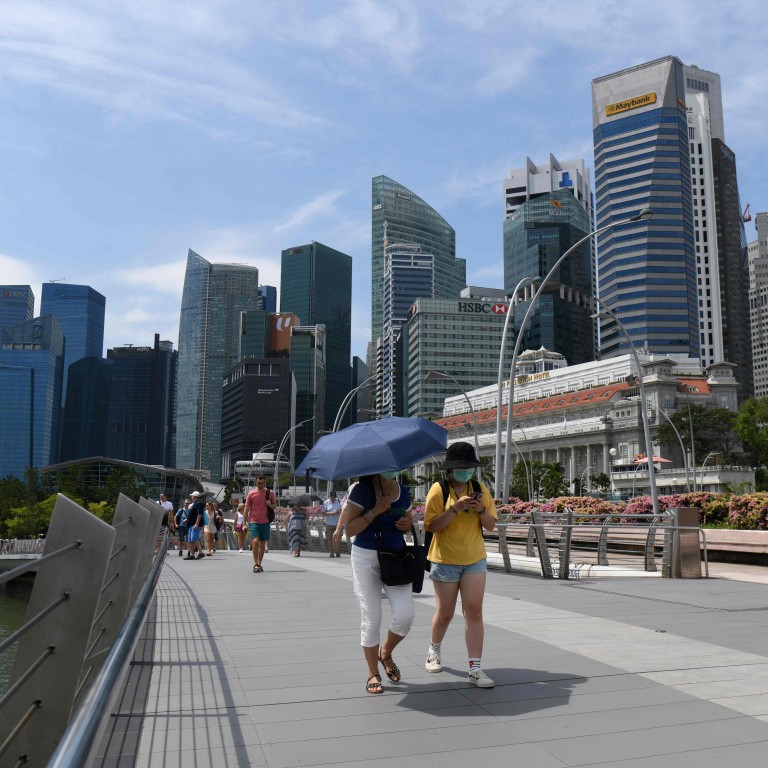
Coronavirus: Singapore tightens rules for residents returning from China
- The number of coronavirus infections in the city state has risen to 77, with 24 patients discharged from hospital
- Under new regulations, returnees from China must stay at home at all times for a 14-day period
This came as Singapore announced two new cases on Monday, taking its total number of infections to 77. In all, 24 patients have fully recovered.
Previously, returning Singaporeans and residents with the right to work and live in the city state could leave their homes to buy food or household supplies during their two week enforced absence from work or school.
But under the new Stay Home Notice regulations, which come into force on Tuesday, they must remain within their premises at all times. Those caught flouting the notice would be subject to “harsh punishments”, which authorities said could include the revocation of work permits for foreigners, while Singaporeans would be prosecuted under the Infectious Diseases Act.
National Development Minister Lawrence Wong, in announcing the changes on Monday, said there were a “substantial number” of Singaporean citizens, permanent residents and long-term pass holders still in China who were looking to return to the Lion City after the Lunar New Year holidays.
“There is a higher chance now that some of them will be infected with the virus,” he said.
The novel coronavirus has infected over 71,400 people, mostly in mainland China, and claimed over 1,700 lives so far. Singapore has the highest number of coronavirus cases outside mainland China and Japan – where 454 cases were found on a cruise ship docked in Yokohama.
Singapore has evacuated 266 residents from Hubei province, the epicentre of the contagion, and has also identified five clusters where infections were spread locally.
On February 1, the city state banned all foreign nationals travelling from mainland China from entering Singapore, in a bid to stem the spread of the coronavirus.
Only those with the right to live in Singapore – citizens, permanent residents and long-term pass holders such as dependents of skilled workers – could enter if they complied with the 14-day enforced leave of absence.
However, other workers known as work pass holders, who are employed mostly in the construction and manufacturing sectors, were told to remain in China and seek permission from the Manpower Ministry before making arrangements to return to Singapore.
Singapore religious groups cut services as virus clusters emerge
Last weekend, Manpower Minister Josephine Teo said 400 of these applications had been rejected, with the ministry saying it had to stagger the return of workers to Singapore, and that some employers were unable to arrange accommodation for returning workers to serve out their leaves of absence.
About 200 of these applications are approved daily, added Teo.
Wong said those work pass holders allowed to return would also have to be confined to their residences for 14 days without leaving.

The new measure shows that the Singapore government’s approach was “not static” and that it was actively assessing the situation and the corresponding risks involved, Wong said.
About 1,200 people who have come in contact with infected patients are currently serving out quarantine orders. About half of them are housed in government quarantine facilities, which can hold up to about 2,000 people. Wong said that meant there was still some buffer, but the government will still build up the capacity of the facilities in case there is more widespread transmission within Singapore.
Coronavirus: Covid-19 impact already worse than Sars: Singapore PM
Meanwhile, a study by Harvard University has described Singapore’s detection capability as “gold standard” and a benchmark.
Researchers found that almost three times the number of Covid-19 cases could have been found globally if the rest of the world possessed Singapore’s detection expertise.
“We consider the detection of 18 cases by February 4, 2020 in Singapore to be a gold standard of near-perfect detection,” said the report’s authors, adding that they had used a model to estimate the probability of detection in other countries relative to Singapore.
The world is detecting imported cases of Covid-19 at 38 per cent of Singapore’s ability to do so, said four epidemiologists from the Harvard T.H. Chan School of Public Health, in the study that has not yet been peer-reviewed.
“Singapore has historically had very strong epidemiological surveillance and contact-tracing capacity and has shown in the Covid-19 epidemic evidence of a high sensitivity of case detection,” said the researchers.
They also cited a previous study, also by a similar team of Harvard researchers, which found that among countries with substantial travel volume, Singapore had “the highest ratio of detected imported cases to daily travel volume”. Other countries such as Thailand, Australia and South Korea came in at 40 per cent of the city state’s ability to detect imported cases.
“Put another way, this implies that the true number of cases in travellers is at least 2.8 times the number that has been detected,” the study said.
However, Singapore’s detection is “probably not 100 per cent efficient”, and the model was also able to estimate that there are around 1.8 undetected cases for every detected coronavirus patient in the city state.
Additional reporting by Today Online

